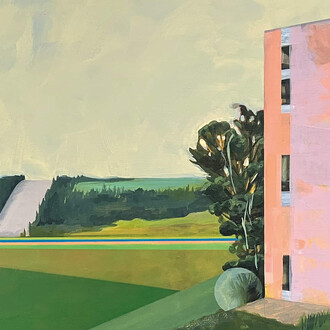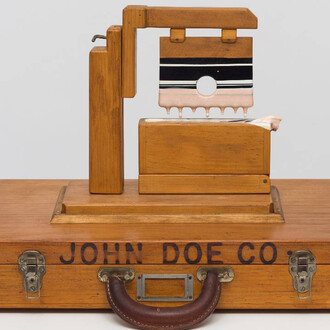Clay is nothing but thick paint, and paint is nothing but thin clay.
(Peter Voulkos)
Gagosian is pleased to present Fire and Clay, a group exhibition of modern and contemporary artists working with the form of the ceramic vessel. Featuring Sylvie Auvray, Shio Kusaka, Takuro Kuwata, Grant Levy-Lucero, Ron Nagle, Sterling Ruby, Peter Voulkos, and Betty Woodman, the exhibition has been organized in collaboration with the independent curator Fabienne Stephan.
From Mayan to ancient Greek pottery, African clay art to the Arts and Crafts movement in England and the United States, ceramic traditions have long united utility and artistry while shedding light on the needs and cultural values of civilizations. Fire and Clay explores the evolution of the ceramic vessel in art from the mid-twentieth century and the California Clay Movement up to the innovative approaches of the present moment.
In 1954, the ceramist Peter Voulkos abandoned crafting utilitarian objects to create sculptures that were rendered with the gestural freedom and power of Abstract Expressionism. Influenced by Japanese ceramists and their embrace of unpredictability and chance during the firing process, his clay vessels and pottery became records of their own making, akin to a jazz song or a Beat poem.
For Betty Woodman, the rhythmic act of working on the potter’s wheel remained primary, as she explored the shape of the vessel as a domestic object, adding symbolic layers to Bauhaus ideals of form and function. Woodman’s work spoke to the traditions of making objects for daily use that would enhance people’s lives. In 1952, after working as a production potter, she traveled to Italy, where exposure to traditions such as majolica (earthenware decorated on the glaze before firing) inspired her to work with the potential of clay as a shape, and as a support for painting with enamels. Her work evolved from simply functional objects to conceptual ones, showing the vase as a vessel, a human body, an animal figure, a metaphor, or an art-historical reference.
Recently, contemporary artists have turned to ceramics in order to challenge the perceived distinction between the decorative and fine arts. Ron Nagle makes what he calls “3-D paintings,” sculptural not only in their form, but also in their textures, edges, and glazed terrains, creating narratives and ironies in expansive, illusionary colors. Grant Levy-Lucero’s vessels are shaped like Greco-Roman amphorae, the ceramic containers ubiquitous during the Bronze Age and Hellenistic period, yet bear the instantly recognizable script and iconography of contemporary consumer brands. With the insignias such as those of Heinz ketchup, Nivea, and Ajax, the function of the vase, pot, or vessel as a household item is imbued with a Warholian modulation of commercial design.
For Sylvie Auvray, the alchemical process of firing lends itself well to her experiments with the melting of materials like glass or vinyl on top of the clay. Her vessels teem with mutant creatures, exaggeratedly organic shapes, oozing glazes, and silhouettes reminiscent of line drawings. She embraces the uncontrollable “imperfections” of ceramics: the cracks, the drips, the unique chemical reactions of the colors of the enamels when applied on different types of clay.
Sterling Ruby’s engagement with clay is rooted in the vernacular and craft history of the earth-derived mineral, as well as in its unique formal possibilities. He rolls, punches, assembles, prods, and manipulates clay by hand or machine to arrive at large basins or vessel-like containers that often hold the debris of previous kiln misfirings. As with the relationship of paint to canvas, the clay provides a responsive, tactile surface as it records Ruby’s bodily gestures. Basin Theology/MIOSIS (2018) exploits the unpredictability of the firing process, presenting shrapnel and broken pieces from past firings.
Takuro Kuwata, with his chawan (tea bowls), addresses the tradition of Japanese ceramics with bold irreverence. Vivid slip colors evade the “demure” reputation of ceramics. He has pioneered the incorporation of needles employed in the construction of kilns, using them in the ceramic works to catch the thick glaze sliding down.
Shio Kusaka’s works unite the traditions of Japanese stoneware and porcelain with Minimalist repetitions and subtle geometries. The responsive tactility necessary for wheel throwing is evident in her newest works. Made in cool, muted tones, the thick liquid glaze stops about three millimeters above the base of each pot—a necessary precaution when kiln-firing, and a subtle reminder of the alchemical transformations inherent to the medium. From liquid to solid, wet to dry, two to three dimensions, the hyper-tactile nature of clay incites a primal desire to shape earth, each potter leaving within the malleable organic material the marks of creative labor.















![Karel Appel, Le coq furieux [The furious rooster] (detail), 1952. Courtesy of Kunstmuseum Bern](http://media.meer.com/attachments/de322f88933729d2014dc4e021d4a6694046a744/store/fill/330/330/c26a6c5ef5e2ed397d4a2e9bc00ac739c40ba8384f45f9ce1ed85adba600/Karel-Appel-Le-coq-furieux-The-furious-rooster-detail-1952-Courtesy-of-Kunstmuseum-Bern.jpg)
